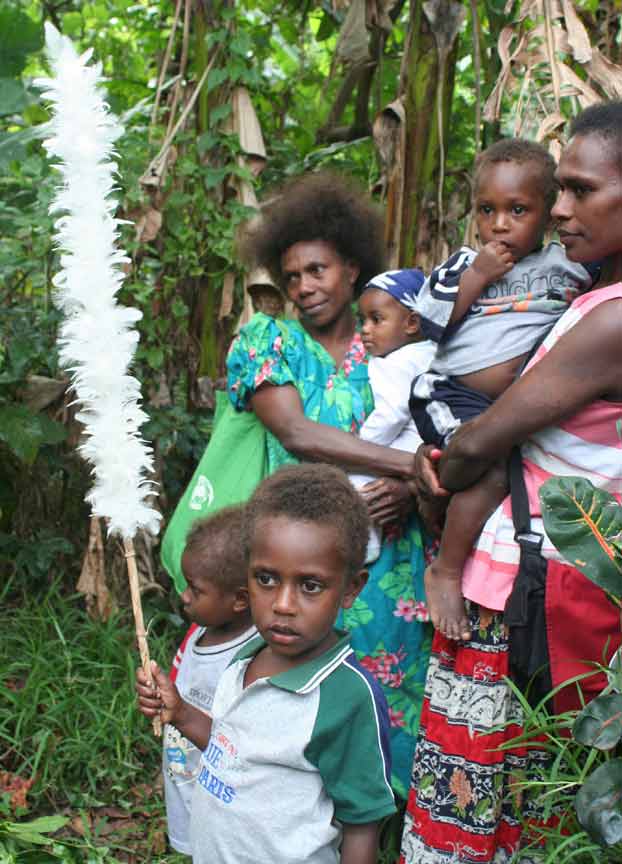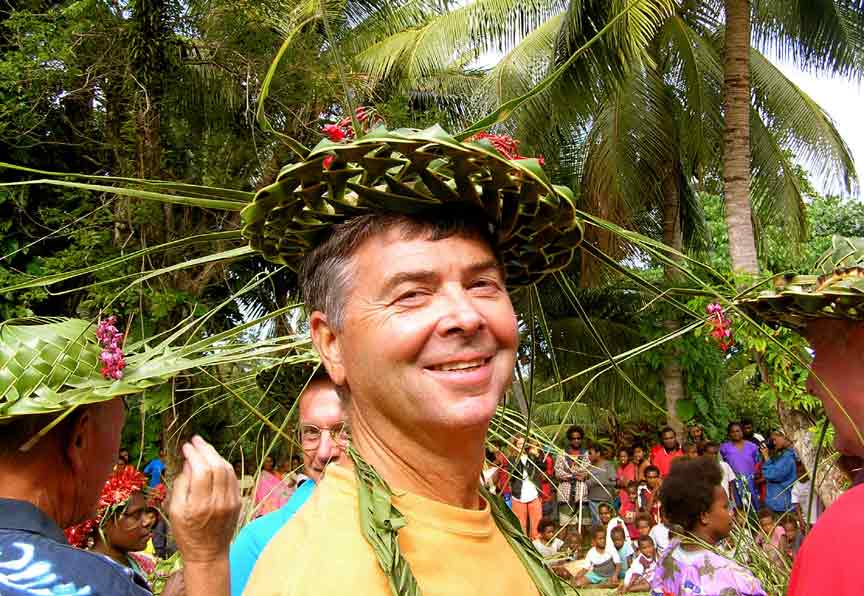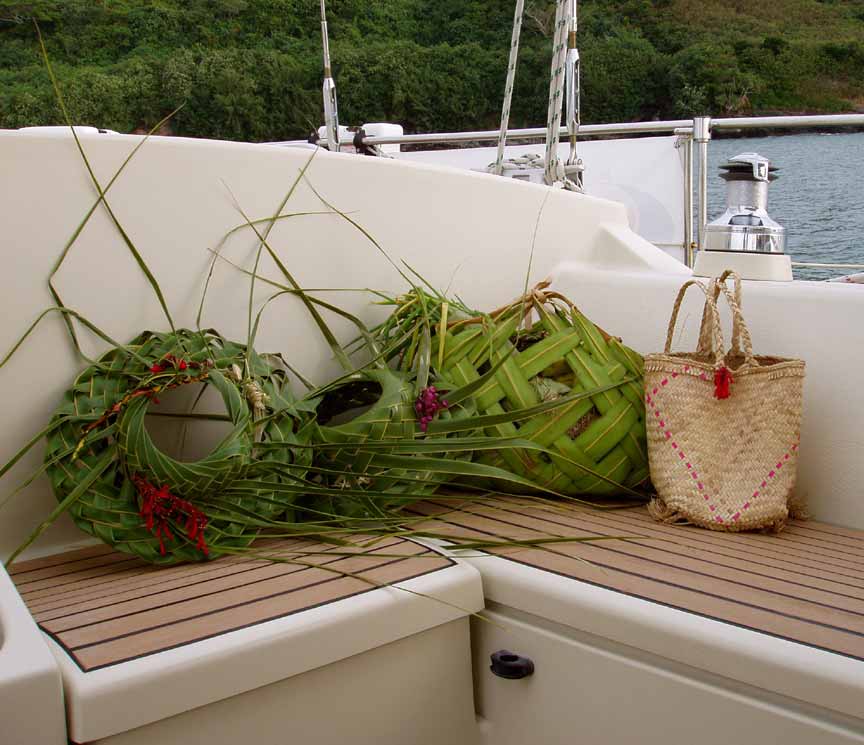Port Resolution, Tanna Island, Vanuatu

Harmonie
Don and Anne Myers
Wed 16 Jul 2008 21:31
|
19:31.549S 169:29.694E
First a little background information on
Vanuatu.
As you can tell from the Google Earth map on this
website, if you head straight west across the Pacific Ocean, with the
exception of New Caledonia, Vanuatu is the last set of islands before
Australia. Technically, Vanuatu is not part of Polynesia (nor is Fiji),
but is part of Melanesia, which encompasses all the Pacific island groups west
of Tonga and south of island groups like the Carolines and Gilberts, which make
up Micronesia to the north. The Melanesians are physically quite different
from the Polynesians. It is hypothesized that the Polynesians descended
from Mongoloid nomads that originally came from the Fukien Province of
China around 5000 BC. The Melanesians are said to also have descended
from the Mongoloids, but with a large dose of Australoids (originally
from Southeast Asia and Australia) mixed in. We could definitely see
the change in the physical features of the people when we moved from
Tonga to Fiji, and now to Vanuatu. The Melanesians have darker skin,
kinkier hair and facial features more like the aborigines of Australia.
The Melanisians are also quite a bit thinner than their Polynesian counterparts
- it's not clear whether this is due to lifestyle or genetics or
both.
Vanuatu is comprised of 83 islands with a total of
5,700 square miles and a population of 206,000 and growing. The percentage
of the population over 63 years of age is only about 3%, whereas those under 15
make up about 42% of the population. Based on the little bit we've seen so
far, those numbers make sense as we have seen a tremendous number of kids (which
are all incredibly cute as you will see). The islands have been home to
many tribes - all of which had a tendency to fight one another (and occasionally
eat one another) in the past. Each tribe has its own language and there
are still over 100 native languages in use in Vanuatu today. All the kids
learn English in school (as well as French in some cases) and most villagers
we've run into speak English quite well. The official language of Vanuatu
is Bislama, which is a compilation of the various forms of pidgin English spoken
throughout the islands as a result of European influence over the years.
In the city of Port Vila, the signs are written in Bislama and sometimes English
as well. Bislama seems quite hilarious to us because it's basically
English spelled and spoken sometimes more logically than the real
thing. In Port Vila the other day we had been told that the best internet
access could be found at the Number One Cafe. We trekked up and down the
main street looking for the cafe and had no luck. Several times we passed
a sign for what we initially thought was the Nambian Cafe, when we stopped and
looked more closely at the sign. It read, 'Nambawan Cafe this
way' with an arrow pointing to the waterfront. It finally dawned on
us...in Bislama, 'Number One' is spelled 'Nambawan' because that is how it
is pronounced in pidgin English. Other Bislama words and
phrases are spelled in the same logical fashion like 'tankyu' for thank you
and 'mi sori' for I'm sorry and 'I orate tankyu' for I'm fine, thank you.
Do you see the beauty in the logic as we now do?
Even more so than Fiji, outside of the capital city
of Port Vila and some of the other larger towns, the people of Vanuatu
still live in much the same way as their ancestors did hundreds of
years before them. Traditional culture is very much alive and is very
important to the people. The people live in small
villages, sometimes in traditional thatch huts, with no electricity except
for the occasional generator used for lights at night and no running water
except for community faucets that draw from rainwater reservoirs on higher
ground or nearby streams. There is no television, no telephones
(we've only spotted one cell phone in our travels, although cell phone towers
are being erected on some of the islands), no radio, no washing machines, no
toilets, no showers, no kitchens, etc. Generally, the villagers don't
travel from island to island (they don't have boats other than dugout canoes
from what we've seen so far), nor do they necessarily travel from village to
village. A supply ship might visit a village once every couple of months
depending on the location of the village.
The villagers are fascinated by what they call
'yachties' (those that visit their islands by sailboat, like us), and as long as
you treat their chief and them with respect, they will bend over backwards
to welcome you. Unlike Fiji, you are not required to offer a gift to the
chief in order to anchor, swim or snorkel in their bay or walk on their
land. You are, however, expected to pay the chief a visit as a show of
respect, and if you plan to walk around, it is expected that you will hire a
local villager as a guide. One of the guidebooks we have suggests this is
a good practice because if left to our own devices, it's possible that
we might mistakenly tramp through the ladies toilet area or somewhere
else equally embarrassing.
The kids in particular are fascinated with us
yachties. As one villager explained, some of the younger kids have never
seen a white person before. When we first set foot on the island of Tanna
in the village of Port Resolution, the kids and their moms and a smattering of
men loitered next to the path leading from the beach to the yachtless Port
Resolution Yacht Club (very similar to the Suwarrow Yacht Club in the Cook
Islands - an open air hut with flags left behind from many yachts hanging from
the thatched roof) so they could get a good look at us. All of them were
friendly, but they generally didn't say anything until we greeted them
first. As we walked up the path behind a parade of World ARC yachties, we
nodded to the people on the sides of the path and greeted them with the Bislamic
'Hallo'. The adults returned the greeting, but the kids just smiled,
stared and acted shy - that is until you snapped their picture and then
showed them their image in the digital camera's window - then you had
giggling friends for life. Between the twenty-five or so World ARC
boats and a few other non-rally boats, there were probably close to thirty boats
in the harbor, which is sure to be a record for the tiny village of Port
Resolution.
Picture 1 - The first two huts we saw when we
entered the village of Port Resolution.
Picture 2 - A few of the kids that watched the
white yachties parade up the beach path to the village. Aren't they
cute?
In preparation for the rally's visit to Port
Resolution, the World ARC people visited Tanna one year ago to gain permission
for all of us to visit, and at that time, World ARC commissioned the building of
a 'World ARC hut' to be used for visiting guests of the village. World ARC
and the 200 villagers also made plans for us to be welcomed in grand fashion
with traditional dancing, music, a gift giving ceremony and a feast. The
welcome was planned for Wednesday, July 9th, the day after we and many of the
other boats arrived in Vanuatu.
At the appointed hour of 1pm, we and the other
boaters dinghied to the beach and filed up the beach path as described above
with the gifts we had brought for the village (lots of school supplies, clothes
and canned food, etc.). The gifts were stowed in one of the visitor's huts
and we were asked to file back down to the beach for our official briefing on
how to behave and what to do throughout the elaborate welcome and gift giving
ceremony. On cue, we filed up a different beach path to a clearing in the
forest where the villagers had assembled (picture 3 - some of the assembled
villagers). Once there, we moved to a position opposite that of the
villagers and waited quietly while the male dancers filed in, followed by their
female counterparts. Then the dancing began. This was completely
different than anything we had seen so far. The men led the procession in
a circle - most dressed in sarong-type skirts and various and sundry t-shirts
(saw a couple of Nike t-shirts, which seemed a bit out of place) with some type
of leaves wound around their heads. The women had very
elaborate multi-layered, bright colored costumes on. Obviously
influenced by the missionaries, the first layer the women had on was what is
referred to as 'Mother Hubbard' dresses - flowered muumuu's with puffy sleeves
and big pockets that reach down nearly to the ankles. On top of the
dresses were multi-colored grass skirts and another layer of multi-colored
fabric tied at the shoulder and worn over the dress. The women's faces
were painted, as were some of the men's, and many wore some type of wreath in
their hair. If we had seen the dance before the influence of the
missionaries, the men would only have worn a few leaves strategically placed in
the front and the women would have worn only grass skirts. Too bad for
us.
The dance accelerated in a circular motion with the
men leading the way and all the dancers stomping to the beat, including the kids
that were participating. We could feel the ground vibrate with their
steps. The men chanted and the women sang in a way that reminded us of
African music - a bit haunting, but at the same time, difficult to tear yourself
away from. This was the exact moment in which our
camera battery decided to die. Panic! Tanna was touted as the
highlight of the rally's Pacific crossing and we were stuck with no way to
document the experience? Ugh! Luckily, our pals from Lady Kay agreed
to share their pictures with us - which they did - all 231 of them. Credit
for the rest of the incredible pictures in this entry and the next goes to
Michael and Jackie. They did a much better job of capturing the spectacle
than I would have. Too bad the pictures have to be dumbed down for the
web, but hopefully it's still possible to get some sense of the
scene.
Picture 4 - Dancers
Picture 5 - Some of the littler
dancers.
Picture 6 - Moms and kids on the sideline
watching the dancing.
After a few songs? dances? chants? Not sure
what the right term is, we followed the small band (a couple of guitarists, drum
player and singers) as instructed along the dirt track road to a grass clearing
near the yachtless yacht club hut. Once there, we were greeted with leaf
necklaces and proceeded per the plan to the opposite end of the grass clearing
where we were to stand in a line behind the boat captains. There was more
dancing - just a few of the women this time. No foot stomping, but lots
of waving from side to side and arm movements - positively no hip
wiggles. Michael snapped a bunch of excellent close-ups of the women
dancers painted faces - picture 6 is one of them. After the
dancing, the chief said a few words through an interpreter (the yachtless yacht
club guy) and Andrew, the Managing Director of the World Cruising Club, also
said a few words. Then the boat captains were presented with a woven palm
frond hat (picture 8, that's Michael peeking over Don's shoulder), and the
villagers piled their gifts for us in an artful heap of woven palm frond
baskets to one side, while the appointed boaters piled our gifts for
them in a most non-artful heap of plastic bags to the other
side. A few more speeches, then a few appointed people from each side went
to their respective gift heaps (artful for us, non-artful for them) and brought
a few things back behind the dancers on their side an the boat captains on our
side. Once that was done, the ceremony was complete and the artful gift
baskets were distributed among the boaters while the heap of plastic sacks were
carried away for distribution to the villagers. The whole thing was quite
structured and we were lectured by Andrew beforehand to adhere to the structure
of the ceremony to show respect to the villagers. For a group of usually
unruly boaters, we behaved quite well. Of course there was no alcohol
involved, so that might have had something to do with it.
The gifts from the villagers were all hand made and
gorgeous. They made our plastic bags full of school supplies bought cheap
in Panama and boat logo t-shirts seem tasteless and cold. I'm sure
the supplies were appreciated by the villagers, but their hand made gifts seemed
so much more thoughtful to us. We received a traditional woven shoulder
bag and a big palm frond basket full of fruits and vegetables (picture
9).
We've seen dancing before, but this was the first
time that it was performed as part of a ceremony in a village and not just a
cultural show at a resort or restaurant. This really felt like the real
thing - in fact it was the real thing - with all the families present and the
kids watching and participating. They weren't just doing this because they
wanted to recreate a traditional ceremonial dance, they were doing this because
this is the way they formally welcome guests. It's their custom and the way
they live. Wow.
After the ceremony ended, we moved on to the
volcano tour, which will be a topic of another entry.
Anne
|








